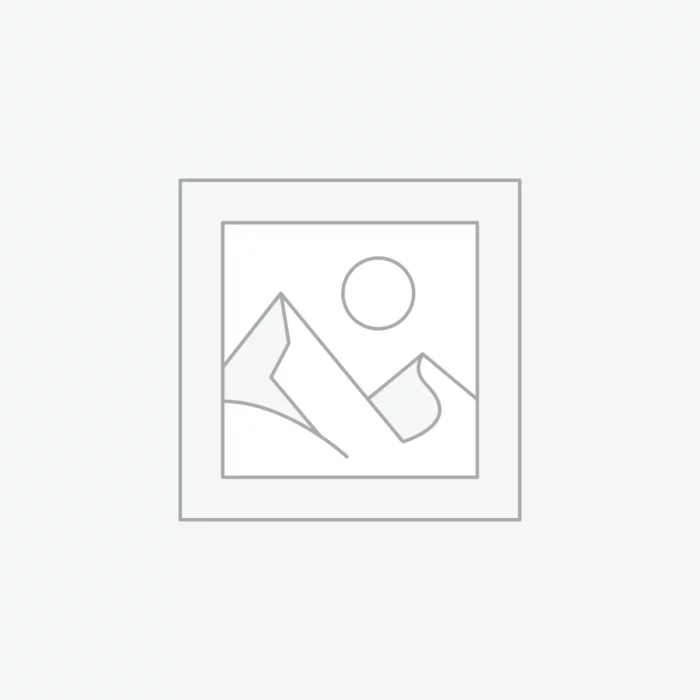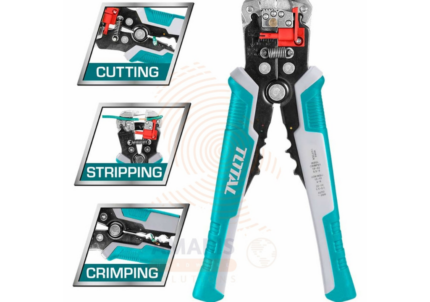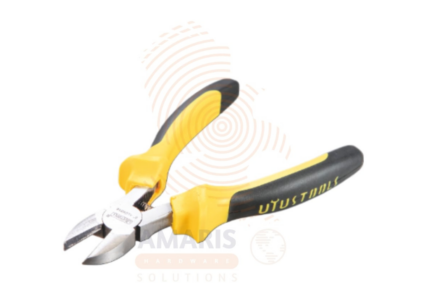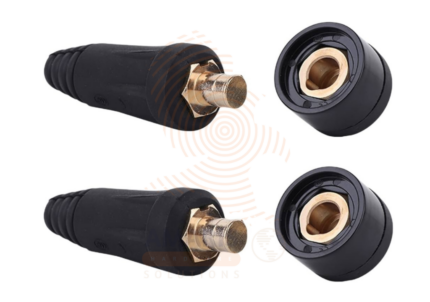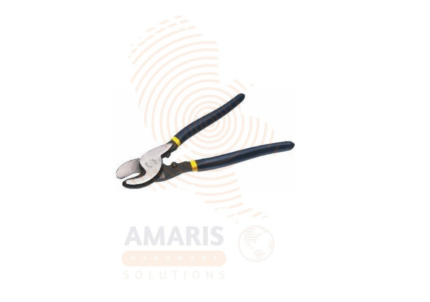
Heavy Duty Cable Cutter
$18.04 Original price was: $18.04.$17.14Current price is: $17.14.
Digital Multi-Meter
WhatsApp Order
A digital multi meter (DMM) is a versatile electronic measuring instrument that combines several measurement functions into a single device. It is commonly used by technicians and engineers to measure electrical parameters such as voltage, current, and resistance in electronic circuits. Unlike analog mustimeters, which use a moving needle to display readings, digital multi meters provide precise and easy-to-read numerical displays. Additionally, many DMMs offer features like continuity testing, diode testing, and capacitance measurement, making them essential tools for troubleshooting and maintaining electrical and electronic systems
Description
Uses of a Digital Multi- Meter
- Voltage Measurement:
- Checking the voltage levels in electrical circuits to ensure proper operation.
- Verifying the output of power supplies.
- Current Measurement:
- Measuring the current flowing through a circuit to assess its performance.
- Troubleshooting issues related to excessive or insufficient current.
- Resistance Measurement:
- Testing the resistance of resistors or other components in a circuit.
- Identifying open or short circuits.
- Continuity Testing:
- Checking for the continuity of a conductor or verifying the integrity of a connection.
- Locating breaks or faults in wiring.
- Diode Testing:
- Verifying the functionality of diodes in electronic circuits.
- Identifying faulty or damaged diodes.
- Capacitance Measurement:
- Measuring the capacitance of capacitors in electronic circuits.
- Assessing the health of capacitors and identifying faulty ones.
- Frequency Measurement:
- Determining the frequency of an AC signal in electronic circuits.
- Troubleshooting issues related to signal frequency.
- Temperature Measurement:
- Some advanced digital multi meters come with temperature measurement capabilities, allowing users to measure temperature in electronic components or environments.
- Transistor Testing:
- Some DMMs have the capability to test transistors for proper functioning.
- Identifying transistor pin configurations and characteristics.
- Battery Testing:
- Checking the voltage of batteries for various devices.
- Assessing the overall health and charge of a battery.
- Fault Diagnosis:
- Locating and diagnosing faults in electrical circuits.
- Troubleshooting electronic devices and systems.
- Automotive Applications:
- Checking the electrical systems in vehicles, including battery voltage and continuity in wiring.
- Troubleshooting automotive electrical issues.
SAFETY HANDLING PRECAUTIONS
- Read the User Manual:
- Before using the DMM, thoroughly read the user manual provided by the manufacturer. This will help you understand the specific features, limitations, and safety precautions related to your particular model.
- Inspect the DMM:
- Before each use, inspect the digital multi meter for any visible damage, exposed wires, or other issues. Do not use a damaged DMM, as it may pose a safety risk.
- Use the Right Function and Range:
- Select the appropriate measurement function and range for the parameter you are measuring. Using the wrong function or range can lead to inaccurate readings and potential damage to the multi meter.
- Check Leads and Probes:
- Ensure that the test leads and probes are in good condition without any visible damage. Use leads with the correct ratings for the measurements you are taking.
- Disconnect Power Sources:
- Before connecting or disconnecting test leads, make sure to turn off power sources and equipment to prevent electrical shock or damage to the multi meter.
- Start with the Highest Range:
- When uncertain about the magnitude of a measurement, start with the highest range and work your way down. This helps avoid overloading the multi meter and protects against potential damage.
- Set to the Off Position:
- When not in use, set the multi meter to the off position to conserve battery life and prevent accidental measurements.
- Be Cautious with High Voltage:
- Exercise extreme caution when working with high-voltage circuits. Ensure that the multi meter is rated for the voltages you are measuring and follow appropriate safety procedures.
- Keep Hands Dry:
- Avoid using the multi meter with wet hands to reduce the risk of electrical shock. If working in damp or wet conditions, take extra precautions and use appropriate personal protective equipment.
- Use Proper Personal Protective Equipment (PPE):
- Depending on the nature of the work, consider using PPE such as safety glasses or gloves to protect against potential hazards.
- Stay Alert and Focused:
- Pay attention to your surroundings and be focused on the task at hand. Avoid distractions to prevent errors or accidents.
- Know Emergency Procedures:
- Familiarize yourself with emergency procedures, such as the location of emergency shut-offs and first aid kits, in case of an accident.
Related products
Automatic Wire Stripper
An automatic wire stripper is a specialized tool designed for efficiently and precisely removing the insulation or sheathing from electrical wires. It typically features adjustable cutting blades or jaws that can be set to the appropriate wire gauge, allowing for the quick and accurate stripping of insulation without damaging the underlying conductive wire. Automatic wire strippers are widely used in electrical and electronics work, automating the process of stripping insulation from wires and enhancing efficiency in tasks such as wiring, soldering, or crimping connections.
Carpenter’s Pencil – Hexagon
A Carpenter's Pencil Hexagon refers to a pencil specifically designed for carpentry work, characterized by its hexagonal shape. Unlike traditional round pencils, the hexagonal shape of a Carpenter's Pencil prevents it from rolling off surfaces and provides a more secure grip, making it practical for precision and control in carpentry tasks. The design also allows for easy identification and retrieval among other tools on a busy work site. Additionally, Carpenter's Pencils often feature a flat or rectangular cross-section, further preventing them from rolling and making them convenient for marking lines with straight edges.
Crimping Pliers for Coaxial Cable
Crimping pliers for coaxial cable are specialized hand tools designed for terminating or connecting coaxial cables by securely attaching connectors to the cable ends. The term "crimping" refers to the process of deforming a metal sleeve or collar around the cable and connector, creating a reliable electrical and mechanical connection. These pliers typically have a jaw or die set that is matched to the specific type and size of coaxial connectors being used. The user places the connector onto the stripped end of the coaxial cable, positions it within the crimping die, and then squeezes the handles of the pliers to compress the metal sleeve, forming a tight and durable connection. This process ensures proper electrical conductivity and prevents signal leakage or interference in coaxial cable installations.
Diagonal Cutting Nippers
Diagonal cutting nippers, also known as diagonal pliers, side cutters, or wire cutters, are hand tools designed for cutting wires, cables, and small materials. The defining feature of these pliers is their sharp, angled cutting edges that allow for a clean and precise cut when snipping through various materials. The diagonal orientation of the cutting blades distinguishes them from other types of pliers, making them particularly useful for reaching into tight spaces and cutting close to a surface. These versatile tools are commonly used in electrical work, crafting, and general maintenance tasks where precision cutting is required.
Digital Multi-Purpose Clamp Meters
A digital multi-purpose clamp meter is a versatile electronic measuring instrument designed to measure electrical current by clamping around a conductor, typically without the need to disconnect the circuit. It combines the functionalities of a digital multi meter with the convenience of a clamp to accurately measure AC and DC currents, voltage, resistance, capacitance, frequency, and other electrical parameters in various applications. The clamp feature allows for non-invasive current measurements, making it suitable for both professionals and hobbyists in fields such as electrical maintenance, troubleshooting, and testing.
Electrician Screwdriver Set
An electrician screwdriver set typically refers to a collection of six individual screwdrivers specifically designed for use by electricians. These screwdriver sets often include a variety of sizes and types of screwdrivers that are commonly used in electrical work. The set may include Phillips and slotted screwdrivers in different sizes, as well as insulated handles to provide electrical safety when working on live circuits. The goal of such a set is to provide electricians with a versatile and comprehensive tool kit to tackle various tasks in the field of electrical work.
Female Connector – Complete
A Female Connector - Complete is a device or component that provides a port or socket designed to accept and mate with a corresponding male connector. In the context of electrical or electronic systems, it typically refers to a receptacle with internal contacts or terminals that establish electrical connections when joined with a male connector, facilitating the transmission of signals, power, or data between devices. The design of female connectors often includes features such as specific shapes, sizes, and locking mechanisms to ensure compatibility and secure connections.
Fence Pliers
Fence pliers are a specialized type of pliers designed for use in fencing and related tasks. They typically feature a combination of functions that make them well-suited for various activities involved in installing, repairing, and maintaining fences. These pliers often include features such as a gripping jaw, wire-cutting blades, a staple puller, and sometimes a hammerhead. The design of fence pliers aims to provide versatility and convenience for professionals or DIY enthusiasts working with fencing materials, wires, and staples.


 Acrylic Sealants
Acrylic Sealants Construction Adhesives
Construction Adhesives Double-Sided Tape
Double-Sided Tape Duct Tape
Duct Tape Electrical Tape
Electrical Tape Epoxy & Resins
Epoxy & Resins Masking Tape
Masking Tape
 Automotive Wrenches & Socket Sets
Automotive Wrenches & Socket Sets Battery Chargers & Jump Starters
Battery Chargers & Jump Starters Car Jacks & Stands
Car Jacks & Stands Car Wash & Detailing Products
Car Wash & Detailing Products Diagnostic Tools
Diagnostic Tools Tire Inflators
Tire Inflators Vehicle Lighting
Vehicle Lighting Oil & Lubricants
Oil & Lubricants
 Adhesives & Sealants
Adhesives & Sealants Bricks & Blocks
Bricks & Blocks Cement & Concrete
Cement & Concrete Drywall & Plaster
Drywall & Plaster Flooring (Tiles, Wood, Laminate)
Flooring (Tiles, Wood, Laminate) Lumber & Plywood
Lumber & Plywood Paints, Primers & Coatings
Paints, Primers & Coatings Insulation Materials
Insulation Materials Roofing Materials
Roofing Materials
 Circuit Breakers
Circuit Breakers Electrical Cables & Wires
Electrical Cables & Wires Switches & Sockets
Switches & Sockets Fuses & Relays
Fuses & Relays Connectors & Terminals
Connectors & Terminals Electrical Boxes & Panels
Electrical Boxes & Panels Conduit & Fittings
Conduit & Fittings Lighting Fixtures & Bulbs
Lighting Fixtures & Bulbs Extension Cords & Power Strips
Extension Cords & Power Strips
 Anchors
Anchors Bolts
Bolts Clips & Clamps
Clips & Clamps Screws
Screws Nuts
Nuts Washers
Washers Rivets
Rivets Nails
Nails Threaded Rods
Threaded Rods
 Hammers
Hammers Measuring Tools (Tapes, Levels, Calipers)
Measuring Tools (Tapes, Levels, Calipers) Screwdrivers
Screwdrivers Pliers & Cutters
Pliers & Cutters Saws & Blades
Saws & Blades Chisels & Punches
Chisels & Punches Allen Keys & Hex Keys
Allen Keys & Hex Keys Ratchets & Socket Sets
Ratchets & Socket Sets Wrenches & Spanners
Wrenches & Spanners
 Power Tool Accessories (Blades, Bits, Discs)
Power Tool Accessories (Blades, Bits, Discs) Rotary Tools
Rotary Tools Saws (Circular, Jigsaw, Reciprocating)
Saws (Circular, Jigsaw, Reciprocating) Drills & Drivers
Drills & Drivers Grinders & Sanders
Grinders & Sanders Heat Guns
Heat Guns Nail Guns
Nail Guns Impact Wrenches
Impact Wrenches Batteries & Chargers
Batteries & Chargers
 Pipes & Fittings (PVC, Copper, PEX)
Pipes & Fittings (PVC, Copper, PEX) Plumbing Tools
Plumbing Tools Pumps & Motors
Pumps & Motors Sealants & Adhesives for Plumbing
Sealants & Adhesives for Plumbing Valves & Taps
Valves & Taps Water Heaters
Water Heaters Drainage Systems
Drainage Systems Faucets & Fixtures
Faucets & Fixtures Hoses & Tubing
Hoses & Tubing
 Hinges & Latches
Hinges & Latches Hooks & Brackets
Hooks & Brackets Window Hardware
Window Hardware Chains & Cables
Chains & Cables Casters & Wheels
Casters & Wheels Shelving & Storage Systems
Shelving & Storage Systems Door Handles & Locks
Door Handles & Locks Drawer Slides & Cabinet Hardware
Drawer Slides & Cabinet Hardware
 Personal Protective Equipment (PPE)
Personal Protective Equipment (PPE) Respirators & Masks
Respirators & Masks Safety Glasses
Safety Glasses Safes
Safes Security Cameras
Security Cameras Gloves
Gloves Helmets
Helmets Ear Protection
Ear Protection Fire Safety Equipment
Fire Safety Equipment Locks & Padlocks
Locks & Padlocks Motion Sensors & Alarms
Motion Sensors & Alarms
 Garden Fencing
Garden Fencing Garden Furniture Hardware
Garden Furniture Hardware Lawn Mowers
Lawn Mowers Trimmers & Edgers
Trimmers & Edgers Shovels & Spades
Shovels & Spades Rakes & Hoes
Rakes & Hoes Pruning Shears & Loppers
Pruning Shears & Loppers Watering Systems (Hoses, Sprinklers, Nozzles)
Watering Systems (Hoses, Sprinklers, Nozzles)
 Interior Paints
Interior Paints Paint Brushes & Rollers
Paint Brushes & Rollers Paint Strippers & Thinners
Paint Strippers & Thinners Paint Trays & Accessories
Paint Trays & Accessories Exterior Paints
Exterior Paints Spray Paints
Spray Paints Primers & Undercoats
Primers & Undercoats Varnishes & Stains
Varnishes & Stains
 Gaskets & Seals
Gaskets & Seals Hydraulic Fittings
Hydraulic Fittings Industrial Fasteners
Industrial Fasteners Industrial Hoses
Industrial Hoses Lubricants & Greases
Lubricants & Greases Metal Sheets & Bars
Metal Sheets & Bars Bearings & Bushings
Bearings & Bushings Belts & Pulleys
Belts & Pulleys
 HVAC Filters
HVAC Filters Insulation for HVAC
Insulation for HVAC Air Conditioners
Air Conditioners Refrigerants
Refrigerants Ventilation Ducts & Fittings
Ventilation Ducts & Fittings Thermostats & Controllers
Thermostats & Controllers Fans & Blowers
Fans & Blowers
 Pegboards & Hooks
Pegboards & Hooks Shelving Units
Shelving Units Storage Bins & Containers
Storage Bins & Containers Toolboxes & Tool Chests
Toolboxes & Tool Chests Workbenches
Workbenches Drawer Organizers
Drawer Organizers Labeling Supplies
Labeling Supplies
 Welding Accessories (Clamps, Brushes)
Welding Accessories (Clamps, Brushes) Welding Electrodes & Rods
Welding Electrodes & Rods Welding Helmets & Gloves
Welding Helmets & Gloves Welding Machines
Welding Machines Soldering Irons & Stations
Soldering Irons & Stations Flux & Solder Wire
Flux & Solder Wire
 Generator Accessories
Generator Accessories Inverters
Inverters Portable Generators
Portable Generators Power Inverters
Power Inverters Transfer Switches
Transfer Switches Diesel & Gasoline Generators
Diesel & Gasoline Generators
 Transport Equipment: Carts, Dollies, and Hand Trucks
Transport Equipment: Carts, Dollies, and Hand Trucks Storage Solutions: Pallets, Racks, and Containers
Storage Solutions: Pallets, Racks, and Containers Lifting Equipment: Hoists, Cranes, and Jacks
Lifting Equipment: Hoists, Cranes, and Jacks Conveyors and Accessories: Belts and Rollers
Conveyors and Accessories: Belts and Rollers